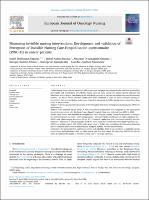Por favor, use este identificador para citar o enlazar este ítem:
https://repositorio.usj.es/handle/123456789/703
| Título : | Measuring invisible nursing interventions: Development and validation of Perception of Invisible Nursing Care-Hospitalisation questionnaire (PINC–H) in cancer patients |
| Autor: | Huércanos-Esparza, Isabel


Antón-Solanas, Isabel 


Orkaizagirre Gómara, Aintzane 

Ramón Arbués, Enrique 


Germán Bés, Concepción 

Jiménez-Navascués, Lourdes 

|
| Palabras clave : | Invisible work; Nursing care; Patient satisfaction; Reliability; Validity; Psychometrics; Nurse; Cancer care |
| Fecha de publicación: | 2021 |
| Editorial : | Elsevier |
| Resumen : | Visible nursing work is usually associated with formal work and physician-delegated tasks which are protocolised and usually well documented. Nevertheless, nurses carry out many actions and display specific attitudes and behaviours which, despite contributing to the well-being, recovery of patients and satisfaction with the attention received, are not as visible. Previous studies have been conducted in order to define 'invisible nursing interventions', but no quantitative instruments focused on measuring invisible nursing interventions have been found in the literature. Purpose: To test the psychometric properties of the Perception of Invisible Nursing Care-Hospitalisation (PINC-H) questionnaire. Methods: Cross-sectional survey design. A self-administered questionnaire was completed by 381 participants recruited consecutively after discharge from a Spanish hospital. Data were collected from 2012 to 2020. Results: Three factors were identified from exploratory factor analysis, namely 'Caring for the person', 'Caring for the environment and the family' and 'Caring presence'. Criterion Validity Coefficient was highly significant (p < 0.001) with values ranging between 0.63 and 0.71. Cronbach's alpha was 0.96. Test-retest reliability was estimated in a subsample of 187 participants; in all the items, correlation coefficients were highly significant (p < 0.001) and within range (0.532-0.811) with a mean value of 0.680. Also, correlations between each dimension and the complete questionnaire indicated good temporal stability between measurements. Conclusions: The instrument had satisfactory validity and reliability. PINC-H can contribute to highlight nursing interventions and behaviours which are often unseen and, thus, less valued. We argue that PINC-H will also be useful to evaluate the quality of invisible nursing care to oncology inpatients. |
| URI : | https://repositorio.usj.es/handle/123456789/703 |
| ISSN : | 1462-3889 |
| Aparece en las colecciones: | Artículos de revistas |
Ficheros en este ítem:
| Fichero | Descripción | Tamaño | Formato | |
|---|---|---|---|---|
| Measuring invisible nursing interventions Development and validation of Perception of Invisible Nursing Care-Hospitalisation questionnaire (PINC–H) in cancer patients.pdf | 2,47 MB | Adobe PDF |  Visualizar/Abrir |
Este ítem está sujeto a una licencia Creative Commons Licencia Creative Commons

